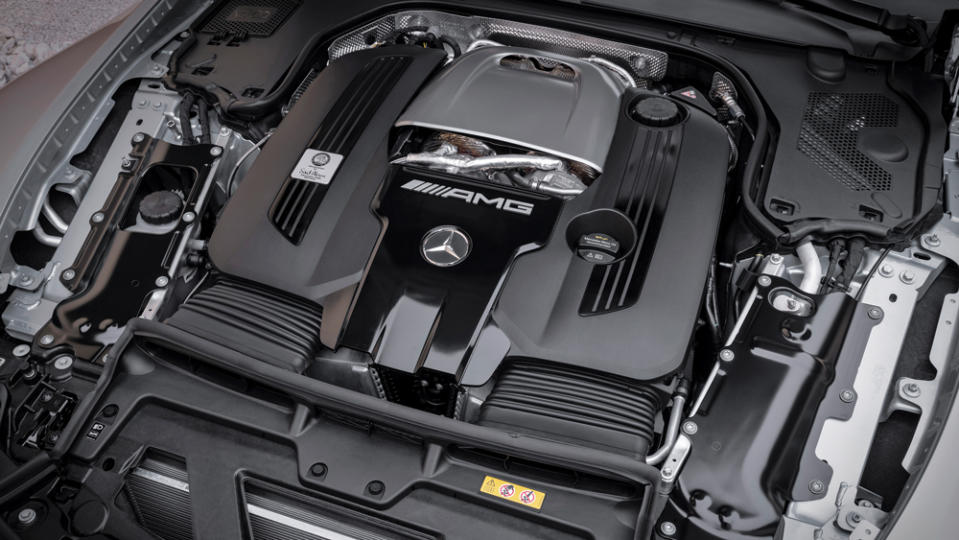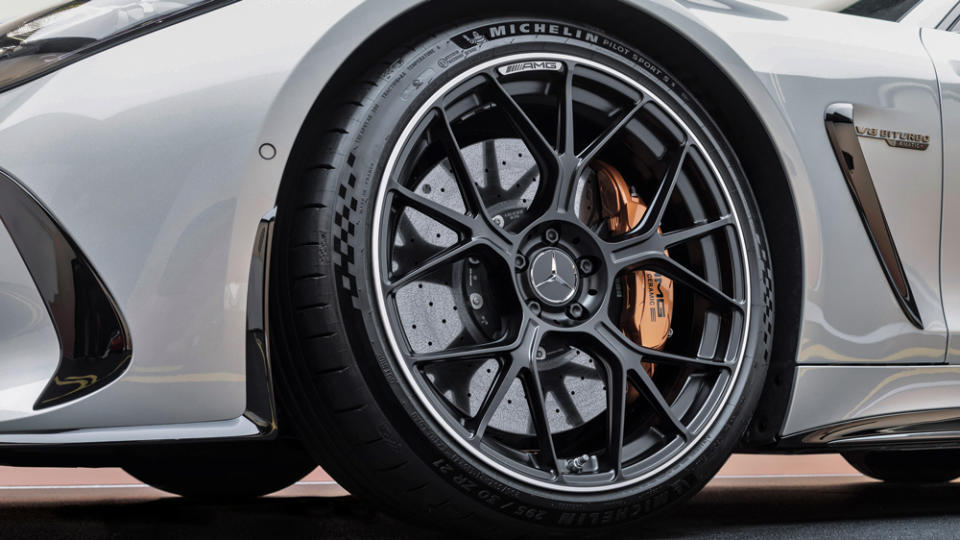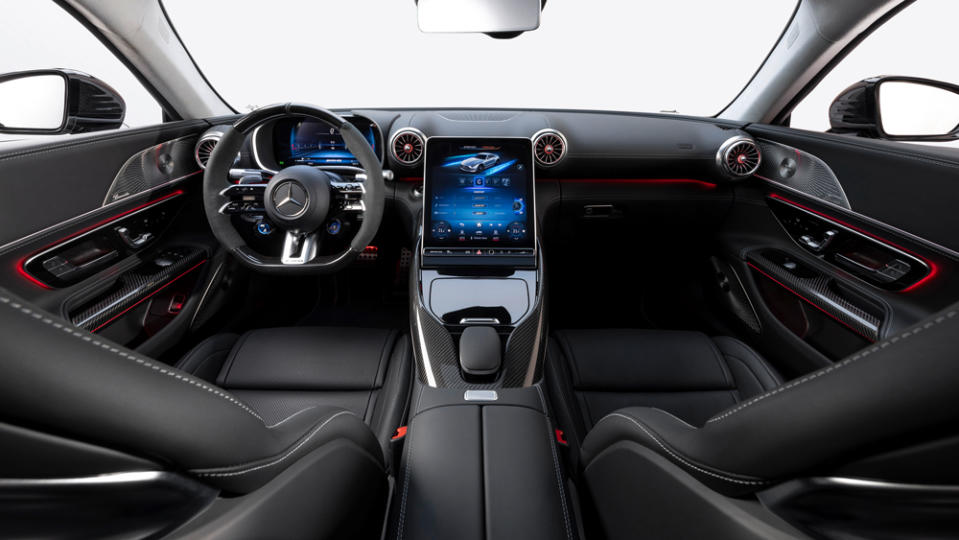Mercedes-AMG’s New GT Halo Car Is Here, and It’s Coming for the Porsche 911

“They are Superman,” acknowledges Mercedes-AMG designer Slavche Tanevski of his crosstown rivals at Porsche and their iconic 911. “This,” he smiles, gesturing at the 2024 Mercedes-AMG GT, “is for the bad boys.” No, it’s not made of Kryptonite, but the all-new AMG GT has been designed from the wheels up to get the attention of potential Porsche 911 buyers.
It’s 7.1 inches longer and 1.6 inches wider than the outgoing GT, and the wheelbase has been lengthened by 2.8 inches, which allows the addition of an optional rear seat—a feature that has long made Porsche’s 911 unique among pure sports cars.
More from Robb Report
Monterey Car Auction Sales Fall 16%, Despite a $30 Million Ferrari
A 1937 Mercedes-Benz Wins Best of Show at the 2023 Pebble Beach Concours d'Elegance
Mercedes-AMG's New 'Big Sur' SL 63 Convertible Pays Homage to the California Coast

Codenamed C192, the new GT is the fourth car independently developed in-house at AMG. Significantly, it shares its platform with the new Mercedes-Benz SL roadster, which has helped reduce the overall development cost. But that also means that AMG’s version is—on paper, at least—less of a hard-core sports car than the outgoing model.
Using the SL platform means that it’s slightly heavier overall than its predecessor; the 4.0-liter twin-turbo V-8 under the hood now sits over the front axle rather than behind it, and there’s no transaxle transmission at the rear. However, AMG says improved power-train-control and chassis-control technologies mean the latest iteration of the GT features a higher level of performance.

“We rethought the car,” says Felix Kern, Mercedes-AMG’s sports-car product manager, who points out that with the rear seat folded flat, this GT has enough interior room to carry a bicycle. “Customers wanted a more practical car, but wanted to keep the performance. They wanted daily usability, but without any compromises.”
The longer wheelbase and longer cabin have changed the proportions compared with the first-generation GT, and for the better. The old car looked rather stumpy at the rear; the new one has a roofline that more elegantly sweeps towards the tail. The 3-D taillights are striking, and the rear diffuser is beautifully integrated into the overall form. Up front, the new grille design cleverly hides vents at the lower sides and underneath.

It’s still recognizably an AMG GT, though. “The first generation was very successful, so we went with an evolutionary approach,” says designer Tanevski. And the same could be said for the mechanicals, as there’s a lot of familiar hardware under that new sheet metal.
AMG’s versatile 4.0-liter V-8 engine, codenamed M177, will be available in two states of tune. A 469 hp version, with 516 ft lbs of torque, will power the AMG GT 53, while the AMG GT 63 is responsible for 577 hp and 590 ft lbs of torque. Both engines are located by active engine mounts and drive all four wheels through AMG’s nine-speed multi-clutch transmission and its performance-tuned 4Matic+ all-wheel-drive system.
AMG’s active-ride-control suspension, with semi-active hydraulic roll stabilization, is standard on both models, as is an electronically controlled limited-slip rear differential and rear-wheel steering. The latter allows the back wheels to move through 2.5 degrees in the opposite direction to the front wheels at up to 62 mph in order to improve low-speed agility. And over 62 mph, all wheels travel in the same direction to improve high-speed stability.

The standard brake setup features steel rotors, but AMG’s high-performance carbon-ceramic brakes are available as an option. The carbon-ceramic brakes are not only lighter, but the front rotors are bigger—16.5 inches, compared with the 15.4 inches that are standard.
Six different drive modes—Smooth, Comfort, Sport, Sport+, Individual, and Race—will allow drivers to tailor the GT’s engine response, ride, chassis, and sound to suit their mood.
Standard equipment on both the AMG GT 53 and GT 63 models include 20-inch alloy wheels, AMG’s Track Pace performance monitoring app, digital LED headlights, and active aero, which includes an air-flow control system and active splitter up front, and an active rear spoiler that deploys at speed.
The interior, which is much more upscale than the outgoing GT’s cabin, features a 12.3-inch LCD instrument display, electrically adjustable AMG sports seats, the AMG performance steering wheel with drive-mode control buttons, and a large central touchscreen controlling the latest version of MBUX.

Options include the folding rear seat, an aero pack that features a fixed rear wing, and Carbon and Night appearance packages like those seen elsewhere across the Mercedes-AMG lineup. In GTs with no rear seat, the bulkhead between the load space and the cabin is fixed, which means you can’t carry that bike. The enhanced flexibility in load space is one reason AMG expects the take rate on the rear-seat option to be very high.

Looking at the hardware, the GT 53 and GT 63 seem almost indistinguishable from the same AMG SL roadster variants. The power and torque figures are identical, and they all have the nine-speed AMG Speedshift transmission and 4Matic+ all-wheel-drive system. But the latest AMG GTs have different spring rates and shock valving, and different power-train and suspension-control logic. Also, the coupe body gives more structural rigidity.
“The positioning and technology are different from SL,” insists Kern. The AMG GT, he says, is designed to be the brand’s halo car, and will be the sportiest car in the AMG lineup. However, when you consider that, in testing, the SL 63 has recorded a zero-to-60 mph acceleration time of 3.1 seconds, and has run the quarter mile in 11.3 seconds at 124 mph, spotting the differences on real-world roads might be hard. We look forward to getting behind the wheel and stepping up to the challenge.
Click here for more photos of the 2024 Mercedes-AMG GT.
Best of Robb Report
Sign up for Robb Report's Newsletter. For the latest news, follow us on Facebook, Twitter, and Instagram.


